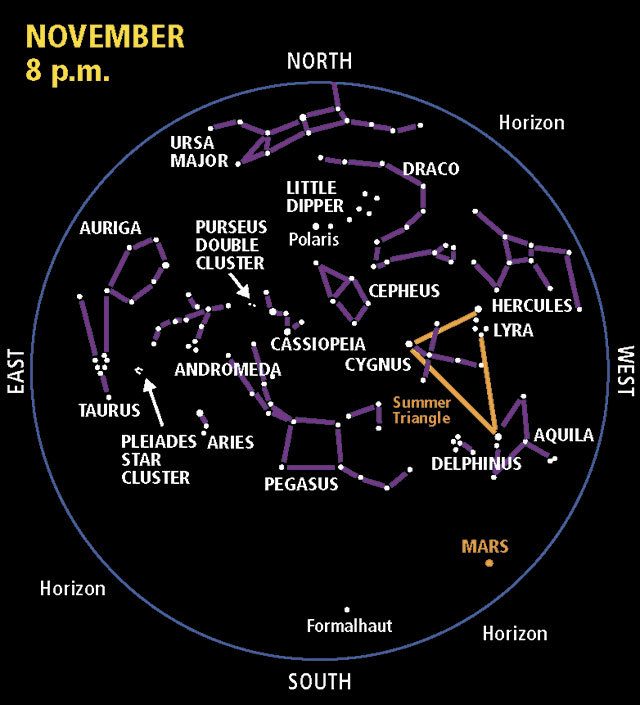As of next Sunday, it will be dark enough for stargazing by 7 p.m. The tradeoff, of course, is that you have to put on a coat and hat in the November air, but it’s worth it.
Some of the early bright constellations of winter are already on the rise on the great celestial stage.
You can’t help but see a beautiful little star cluster in the low eastern sky, resembling a tiny dipper. It’s not the Little Dipper. That’s in the high northern sky. What you’re witnessing is the Pleiades star cluster, the best naked-eye star cluster in the night sky, a group of young stars almost 2,400 trillion miles away.
The Pleiades also has a connection with the spookiness of Halloween. This little cluster was greatly feared by many ancient societies as remote from each other as Egypt, Ceylon, Mexico, and Britain. It was believed that a catastrophe was eventually going to occur when the Pleiades reached their highest point in the late night sky about this time of year. As you’re trick or treating Monday night, keep an eye out for the Pleiades, but don’t be afraid of them
.
Another thing to keep an eye out for early this week are three planets in the very low south-southwest sky very early in the evening. The planets Venus and Saturn are in a very close celestial hug, less than 3 degrees apart, but you can only see them if you have a good view of the southwest horizon. Toward the end of evening twilight they’ll be barely above the horizon. Venus will be the much brighter of the two with Saturn to the upper right of Venus. Forget about checking them out with your telescope. They’ll both show up really fuzzy because of the blurring effects of our atmosphere that’s extreme along the horizon. You won’t see them on the November star map because the map is set for 8 p.m., and by then Venus and Saturn will have already slipped below the horizon. This coming Wednesday and Thursday the new crescent moon will be passing above the planets and it should be quite a show.
Mars is the third planet visible in the early evening this month. It’s a little higher in the southwest sky as darkness sets in, but like Saturn and Mars it won’t be much of a telescope target because it will also be fuzzed up by Earth’s atmosphere. The first quarter moon will have a close junction with the red planet next weekend.
In the south-southeastern Everett sky is a prime autumn constellations, Pegasus the Winged Horse, with Andromeda the Princess tagging along. Turn and face north and you’ll see old friends like the Big Dipper, barely above the horizon, with the Little Dipper hanging by its handle higher in the northern sky. Cassiopeia the Queen, which forms a giant sideways W, proudly shows off her stuff in the high northeast sky.
In the western sky, some summer constellations are still visible: Cygnus the Swan, Lyra the Harp, and Aquila the Eagle. We won’t see them much longer because as Earth orbits the sun, they’ll earlier and earlier in the evening.
If you’re far enough away from city light, you can still see the Milky Way band, the thickest part of our home galaxy. This milky ribbon made up of billions of stars will roughly stretch north to south across the western half of the sky. Look for it this week because next week the moon will be nearfull stage and the heavens will be just too lit up.
Mike Lynch is an amateur astronomer, professional broadcast meteorologist, and author of the book, “Stars; a Month by Month Tour of the Constellations.”
Talk to us
> Give us your news tips.
> Send us a letter to the editor.
> More Herald contact information.

























